Having lost three goals in Turin a week ago, Barcelona looked to mount a comeback in Camp Nou. However, their all-star attack faltered against the Old Lady’s Italian defense. Juventus deservedly knocked out Barcelona in the pursuit of their first Champions League title in twenty one years.
Line Ups

Made using TacticalPad
Barcelona: (1. ter Stegen) // (20. Sergi Roberto) – (3. Pique) – (23. Umtiti) – (18. Jordi Alba) // (4. Rakitic) – (5. Busquets) – (8. Iniesta) // (10. Messi) – (9. Suarez) – (11. Neymar)
Juventus: (1. Buffon) // (23. Dani Alves) – (19. Bonucci) – (3. Chiellini) – (12. Alex Sandro) // (5. Pjanic) – (6. Khedira) // (26. Cuadrado) – (21. Dybala) – (17. Mandzukic) // (9. Higuain)
Tactical fight in the early stage of the game
What became apparent from this tie is that Massimiliano Allegri out-coached Luis Enrique, because Juventus had answers for most of the things Barcelona tried to throw at them.
Having to turn around the three goal deficit, Enrique said that Barcelona had no choice but to take the risk and attack. From the start of the game, Barcelona’s players were looking to be extremely aggressive and tried to retrieve the ball as soon as possible when Juventus was in possession:
To be able to carry out such an aggressive approach to press their opponents, Barcelona had to take two risks: 1. Barcelona had to adopt a ball-orientated man-marking scheme. Such defensive strategy exerts extremely high pressure on ball handlers but is also dangerous because the defensive shape of a team is distorted and leaves too much space for the opponents to penetrate. 2. To facilitate this high-intensity pressing, Barcelona played with a very high defense line throughout the game, with their last defenders, Samuel Umtiti and Gerard Pique, positioned all the way past the mid-line.
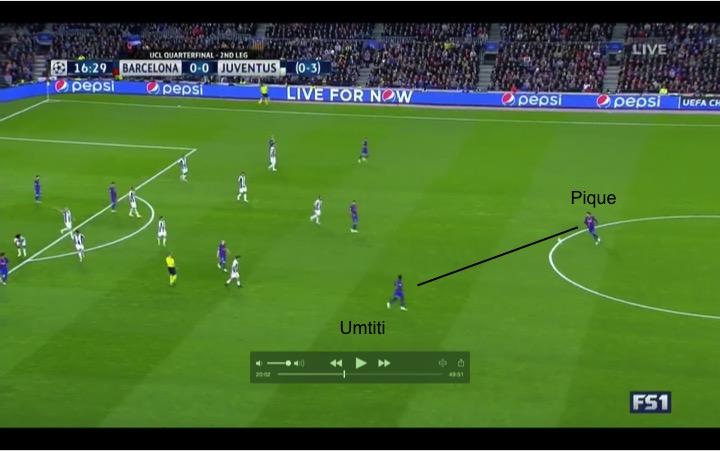
Both Umtiti and Pique positioned way past the mid-line. Pique was the last on-field player. Barcelona took a big risk because the offside rule does not apply after the mid-line.
Enrique hoped that the intense pressure could force Juventus to commit errors and allow Barcelona to score in the early stages of the game so that they could mount a comeback like they did against Paris Saint-Germain. However, Enrique’s plan did not work out. Allegri’s Juventus diffused these pressures brilliantly. Instead of sitting back to absorb the early pressure, Juventus held a high press against Barcelona:
Juventus carried out these high presses against Barcelona for the opening ten minutes. These high presses allowed Allegri’s team to control the majority of the possession and the tempo in this period. For example, Juventus managed 63% of the possession and limited Barcelona’s pass success rate to 59%.
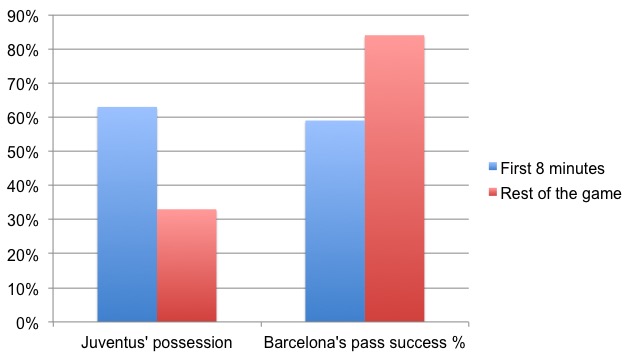
Although Juventus was not able to score at the early stage, they completely disrupted Barcelona’s rhythm. Most importantly, Barcelona was not able to apply intense pressure on Allegri’s team because they were themselves being pressured. Such tactics prevented Barcelona from causing havoc in Juventus’ half in the early period of the match, an element that was critical for their comeback against PSG.
Juventus defensive structure
The performance of the Juventus’ defense has been well appreciated by football critics, and many have labeled them the best defense in the world right now. There is no doubt about the individual quality of the Juventus players in the defensive phase. But what separates Juventus from most of the teams regarding the defense is their discipline. While the individual quality of a defender is important, what matters the most for a team defense is the commitment of every player to maintain a certain team shape and the elimination of the mistakes. Juventus excelled in all of these areas against Barcelona.
Juventus tried to press Barcelona’s players whenever they recycled the ball to the defenders and the back. Juventus’ press aimed to prevent Barcelona from building up from the back. They tried to block Marc-André ter Stegen’s passing lanes to the closest defenders. Most importantly, they sought to eliminate Sergio Busquets from participating into the build-up by having Sami Khedira man-mark him.
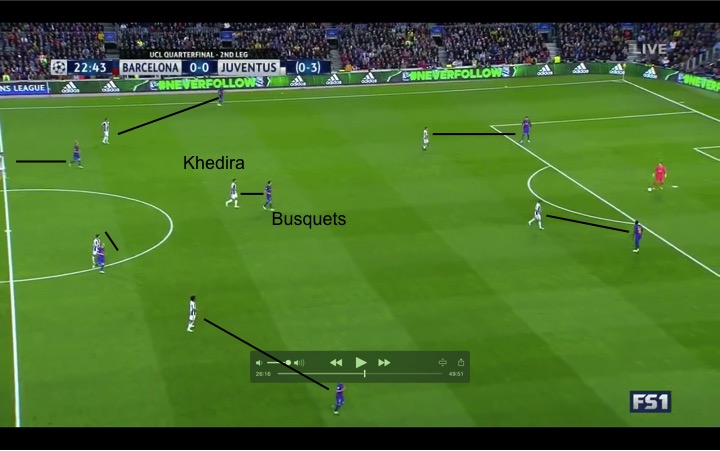
Even Ter Stegen’s passing lanes were blocked. Khedira almost always man marked Busquets when Juventus press Barcelona
Busquets is critical for Barcelona to progress the ball into the opponent’s half. His role in dropping between the center backs to form a back three in the offensive phase is well covered. Moreover, his passing range is also impressive:
In the rare instances when Khedira could not man mark Busquets during Juventus’ press, Busquets was often able to deliver the vertical passes that penetrated the space between the lines. By man-marking Busquets, Juventus limited the passes that Lionel Messi, Andres Iniesta or Neymar would receive directly in front of the last line of the defense.
Barcelona’s offense relies on the positional play and the creativity of Messi, Neymar, and Iniesta. To limit them from creating chances, Juventus also settled into a very narrow and compact 4-4-2 shape for most of the match in the defensive phase.


The close and short distance between the defenders and the midfielders meant that there was very limited amount of space for Barcelona’s players to operate. It was very hard for Barcelona to penetrate past Juventus’ three very close lines of defense by the vertical passes. Messi or Iniesta encountered at least two lines (the midfielders and the defenders) of Juventus’ defense for a majority of the game. The compactness and narrowness of the team’s defensive shape also meant that Messi and co. often had multiple defenders in front of them. Such arrangements make dribbling past the defenders very difficult. In the rare cases when Barcelona was able to find Messi in the spaces between the lines, the closeness between the Juventus’ players meant that he would almost always find himself surrounded by multiple defenders immediately after he received the ball.
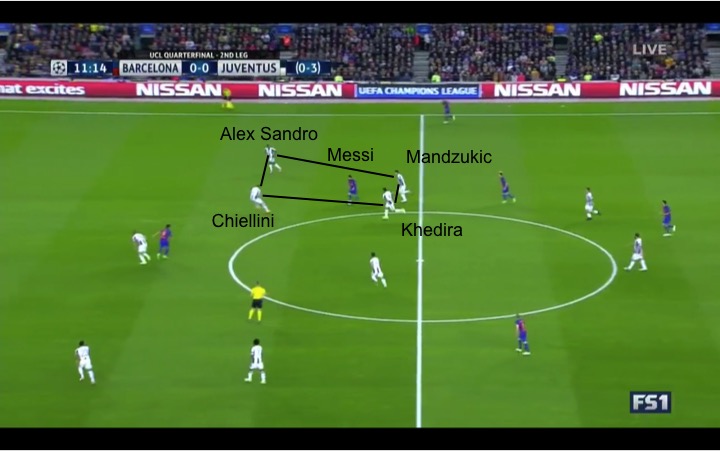
Juventus’ midfielders did an excellent job in maintaining the defensive shape of the team. They were critical because they were the ones who had the direct encounters with Messi, Iniesta, and Neymar for the most of the game. Their hard work allowed Leonardo Bonucci and Giorgio Chiellini to tackle and clear a lot of the balls.
Their contribution in the defense was extremely impressive, considering that three of the four Juventus midfielders were offense-orientated.
With Juventus containing most of the ball progression opportunities in the middle, Barcelona had to advance the ball on the flank. In the first game in Turin, Barcelona started with a 3-4-3 formation and switched to a 4-3-3 formation in the half time to increase the attack on the flanks to stretch Juventus’ defense. In this game, Enrique opted to use Jordi Alba on the left side in order to increase the potency of Barcelona’s attack on this side. Barcelona generated most of their most dangerous chances in this game through the usage of the left side.
Neymar, Jordi Alba, and Iniesta all have excellent passing range, technique, and speed. These similar attributes allow them to become very unpredictable because any of these players can pass or dribble past the defenders and they had to be marked very closely in the offensive phase. Marking them so close means that the defenders could be dragged away (physically or mentally) and left the space behind. Any simple triangle shape between these players is enough to distort the defense.
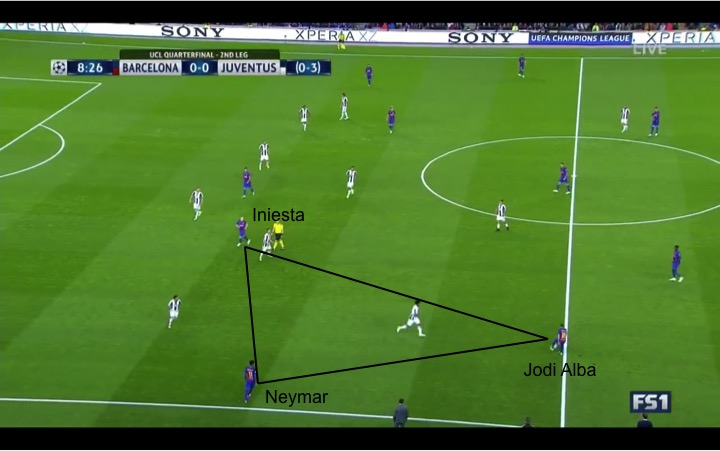
Barcelona was most dangerous when they were able to attack through the left side in this game. However, the most dangerous player was not Neymar or Iniesta, but Jordi Alba.
Both Neymar and Iniesta relied too much on their dribbles in the offensive phase. In particularly, Neymar was always trying to dribble past multiple Juventus defenders and was largely ineffective. In the cases when Barcelona’s attack was able to open Juventus’ defense with Jodi Alba, the very close distance between Juventus’ players meant that there was always a covering defender.
Conclusion
Allegri’s team repelled waves and waves of Barcelona’s attack. Their strategies and disciplined team defense stopped Barcelona from generating too many dangerous situations where Messi and Neymar thrive. Without any alternative plan, Barcelona could not break Juventus. Barcelona’s offense was one-dimensional, and the team incredibly imbalanced.
Juventus played impressive football throughout the two games against Barcelona. It is incredible that Allegri was able to turn multiple offensive-orientated players into disciplined defensive players. Therefore, the team is incredibly balanced, and Juventus’ players were able to interpret various strategies and tactics in different phases of the match. With the self-belief and confidence they gain from this tie, they will be a formidable contender in the Champions League.
Read all our tactical analyses here























































